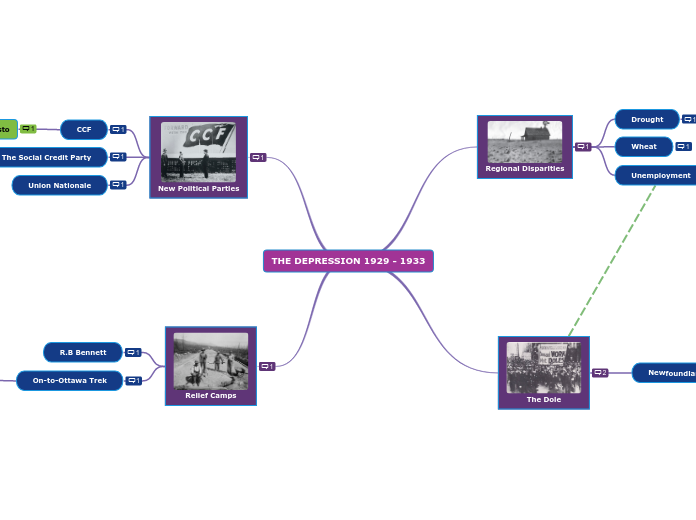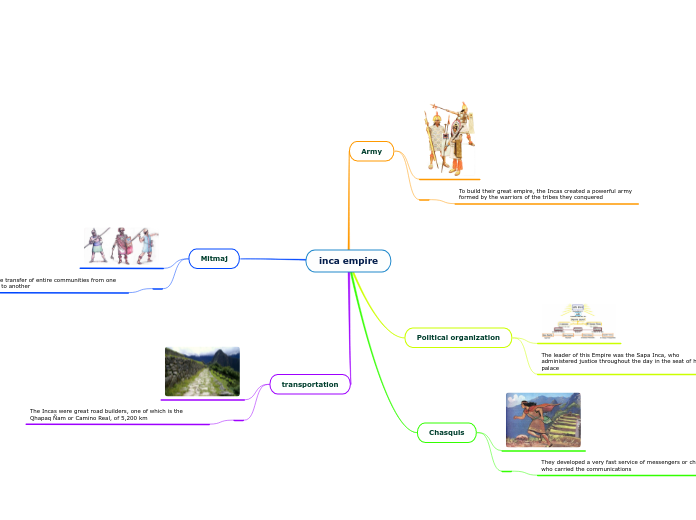THE DEPRESSION 1929 - 1933
Relief Camps
The Depression - Relief Camps. Due to the terrible unemployment rates caused by the Depression, young single men searched for jobs all across Canada. To alleviate this problem relief camps were created in Ontario and British Columbia by the Federal government. The men from these camps were given jobs such as cutting down trees and building new roads.
On-to-Ottawa Trek
Relief Camps - On-to-Ottawa Trek. The On-to-Ottawa Trek was an event indirectly caused by the Depression. In the relief camps men were paid very little and lived in very poor conditions. They decided they were fed up with the treatment and planned to travel to Ottawa on freight trains to plead their case to the Prime Minister.. The trekkers were approximately 2000 strong.
Regina Riot
Regina Riot - On-to-Ottawa Trek. In April 1935, many of the men in the B.C. camps staged a walkout to demand better working conditions and higher wages. On their way to Ottawa, they eventually made their way to Regina. Citizens joined their march, but the Federal Government was determined to stop them there. Police officers attempted to arrest the trek leaders and the trekkers panicked and rioted. This effectively put an end to the On-to-Ottawa Trek.
R.B Bennett - Relief Camps. Relief Camps were create by Bennett when in 1932, General Andrew McNaughton, a WW1 veteran suggested the idea as a way to create jobs for young, unmarried men who were unemployed and needed money.
New Political Parties
The Depression - New Political Parties. Many new political parties were born from the Depression. They all sought to promised to improve the economy in their own way.
Union Nationale
New Political Parties - Union Nationale. This new provincial party in Quebec focused on issues that concerned Francophones. It attracted voters because of its reform agenda, which included higher minimum wages and a provincially owned hydroelectric system.
The Social Credit Party
New Political Parties - The Social Credit Party. Another successful Western movement that was created during the Great depression was the
Social Credit Party, which was led by William Aberhart. He believed that the Depression would be eradicated if people had more money to spend and wanted citizens to receive $25 per month.
CCF
New Political Parties - CCF. The CCF or "The Co-operative Commonwealth Federation", was one of the most successful political parties to emerge from the Depression. CCF members wanted to dismantle the free enterprise economic system, which they believed had caused the Depression.
The Regina Manifesto
CCF - The Regina Manifesto. The Regina Manifesto was created by the CCF. It declared that the CCF was going to “eliminate the domination and exploitation of one class by another” and they planned to restore economic equality.
The Dole
The Depression - The Dole. Due to the terrible unemployment rates, the Dole was created out of the Depression by the government. It was created to give the unemployed essentially a free meal plan. Although, it lacked nutritional value and caused sicknesses.
The Dole - Unemployment. The Dole was created by the Federal government to combat severe unemployment. The Dole gave the unemployed a small wage to buy specific foods from a list. Many of the unemployed were against the Dole or thought that it did not provide enough food and the food they were able to choose from lacked nutritional value.
Newfoundland
Newfoundland - The Dole. Healthcare and school were not publicly funded. Newfoundland and Labrador and many people could not afford these necessities . If people did manage to save a small amount of cash for medical or other emergencies, they risked disqualification from the dole. Some government officials and members of the country's elite believed people in Newfoundland were receiving relief when they did not really need it. Citizens were taken off the relief, forced to sell their remaining possessions and spend what little they had left.
Regional Disparities
The Depression - Regional Disparities. The Prairies and the Maritimes were hardest hit during the Depression because they relied on natural resources to maintain their economy. They were impacted heavily by drought and infestation and a decreased demand for their resources.
Unemployment
Regional Disparities - Unemployment. In the Prairies wheat prices fell and many farmers' were left struggling and unemployed . In the Maritimes and British Columbia, people suffered economically when fish and lumber markets dried up. Unemployment rates in the Maritimes, British Columbia and Prairies grew as workers from other parts of Canada arrived looking for jobs that did not exist.
R.B Bennett
Unemployment - R.B Bennett. In order to win the election, Bennett promised to solve the unemployment problem in the country. However, when he was elected, he put the unemployment problem on Municipal and Provincial governments. He was opposed to spending federal money to help solve the problem. While he was in power the unemployment rates got worse, and Canadian citizens demanded change.
Wheat
Regional disparities - Wheat. In the Prairies specifically, wheat prices plummeted drastically during the great Depression. This deeply affected the farmers in the Prairies and the economical stability of the Prairies as a whole . Since there were very few factories in the Prairies at the time, being a farmer was one of the only ways to make a good living.
Drought
Regional Disparities - Drought. The Drought heavily effected the Prairies. Even with government help, many farmers could not maintain their operations and were forced to leave their land.
First Nations
Drought - First Nations. First Nation farmers in the Prairies were deeply impacted by drought. Crop failure, poor health and a decline in prices were all caused by drought. First Nation farmers' were not supported by the government in any way and had to survive in the harsh conditions all on their own.









